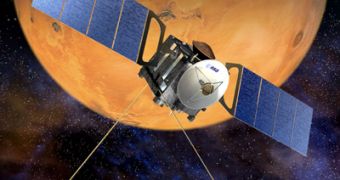The same sand storm that crippled the Spirit and Opportunity Martian rovers this summer was apparently studied by the Mars Express Spacecraft orbiting our sister planet, revealing that it generated a rise in the Red Planet's temperature of about 20 to 30 degrees Celsius.
The storm observed this year started developing in end of the month of June, and by the middle of July it completely covered the surface with a thick cloud of dust that started dispersing, as the storm finally stopped at the end of August. As soon as the atmosphere of the planet became full with dust, it blocked most of the light coming form the Sun, filtering out only 20 percent of the total solar radiation received by the planet, which eventually reached the surface.
The rest of the light, which has either been reflected back into space, or it has been absorbed by the actual dust cloud, determined a temporary rise in the temperature of Mars' thin atmosphere. The measurements have been gathered with the help of the Planetary Fourier Spectrometer on board the Mars Express spacecraft, which is normally used to analyze the composition of the atmosphere, by collecting the reflected sunlight from the atmosphere, and the infrared radiation emitted in the process.
Usually, these sand storms, which rage on the whole surface of the planet, begin in the summer in the southern regions of the planet, as its elliptical orbit around the Sun determines southern summers to be far more hotter than the northern ones, due to the fact that during this time Mars is closer to the Sun.
Now, scientists believe that a key element in triggering these sand storms is the presence of large structures in the vicinity of the south pole, like Hellas Basin for example, that is about 9 kilometer deep and more that two thousand kilometers in diameter, determining an irregular pattern in the air circulation of the atmosphere.
Unlike other planets, which protect the polar regions by forming atmospheric pockets of air that stop the equatorial air currents from reaching them, Mars seems to make an exception, as the dust storms cover the whole surface of the planet; the latter can remain in suspension for a few months after the storm has passed, with microscopic particles of sand staying in the atmosphere for years.
Also, there is still no explanation for the pattern of occurrence of these sand storms, as they seem to come every few years. Theoretically, the heat produced by the sand clouds should remain trapped in the planet's atmosphere; however, it is quickly dissipated, as the surface does not receive additional sunlight to support a further heating process.

 14 DAY TRIAL //
14 DAY TRIAL //